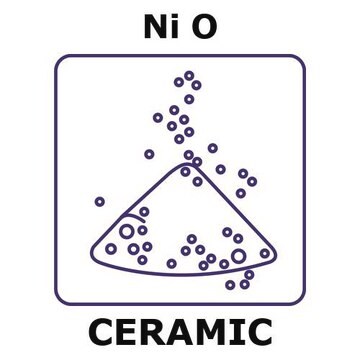203882
Nickel(II) oxide
99.99% trace metals basis
Synonym(s):
Nickel monoxide, Nickelous oxide
About This Item
Recommended Products
Assay
99.99% trace metals basis
form
powder and chunks
composition
NiO
greener alternative product characteristics
Design for Energy Efficiency
Learn more about the Principles of Green Chemistry.
sustainability
Greener Alternative Product
color
green
density
6.67 g/mL at 25 °C (lit.)
application(s)
battery manufacturing
greener alternative category
SMILES string
[Ni]=O
InChI
1S/Ni.O
InChI key
GNRSAWUEBMWBQH-UHFFFAOYSA-N
Looking for similar products? Visit Product Comparison Guide
General description
Application
- non-enzymatic glucose sensor
- hydrogen production
- dye-sensitized solar cells (DSSCs)
Signal Word
Danger
Hazard Statements
Precautionary Statements
Hazard Classifications
Aquatic Chronic 4 - Carc. 1A Inhalation - Skin Sens. 1 - STOT RE 1 Inhalation
Target Organs
Lungs
Storage Class Code
6.1C - Combustible acute toxic Cat.3 / toxic compounds or compounds which causing chronic effects
WGK
WGK 1
Flash Point(F)
Not applicable
Flash Point(C)
Not applicable
Personal Protective Equipment
Choose from one of the most recent versions:
Already Own This Product?
Find documentation for the products that you have recently purchased in the Document Library.
Customers Also Viewed
Articles
As with all types of fuel cells, a Solid Oxide Fuel Cell (SOFC) is capable of efficiently transforming chemical energy into electrical energy.
Thermoelectric Performance of Perovskite-type Oxide Materials
The prevailing strategies for heat and electric-power production that rely on fossil and fission fuels are having a negative impact on the environment and on our living conditions.
Professor Chen (Nankai University, China) and his team explain the strategies behind their recent record-breaking organic solar cells, reaching a power conversion efficiency of 17.3%.
Our team of scientists has experience in all areas of research including Life Science, Material Science, Chemical Synthesis, Chromatography, Analytical and many others.
Contact Technical Service







